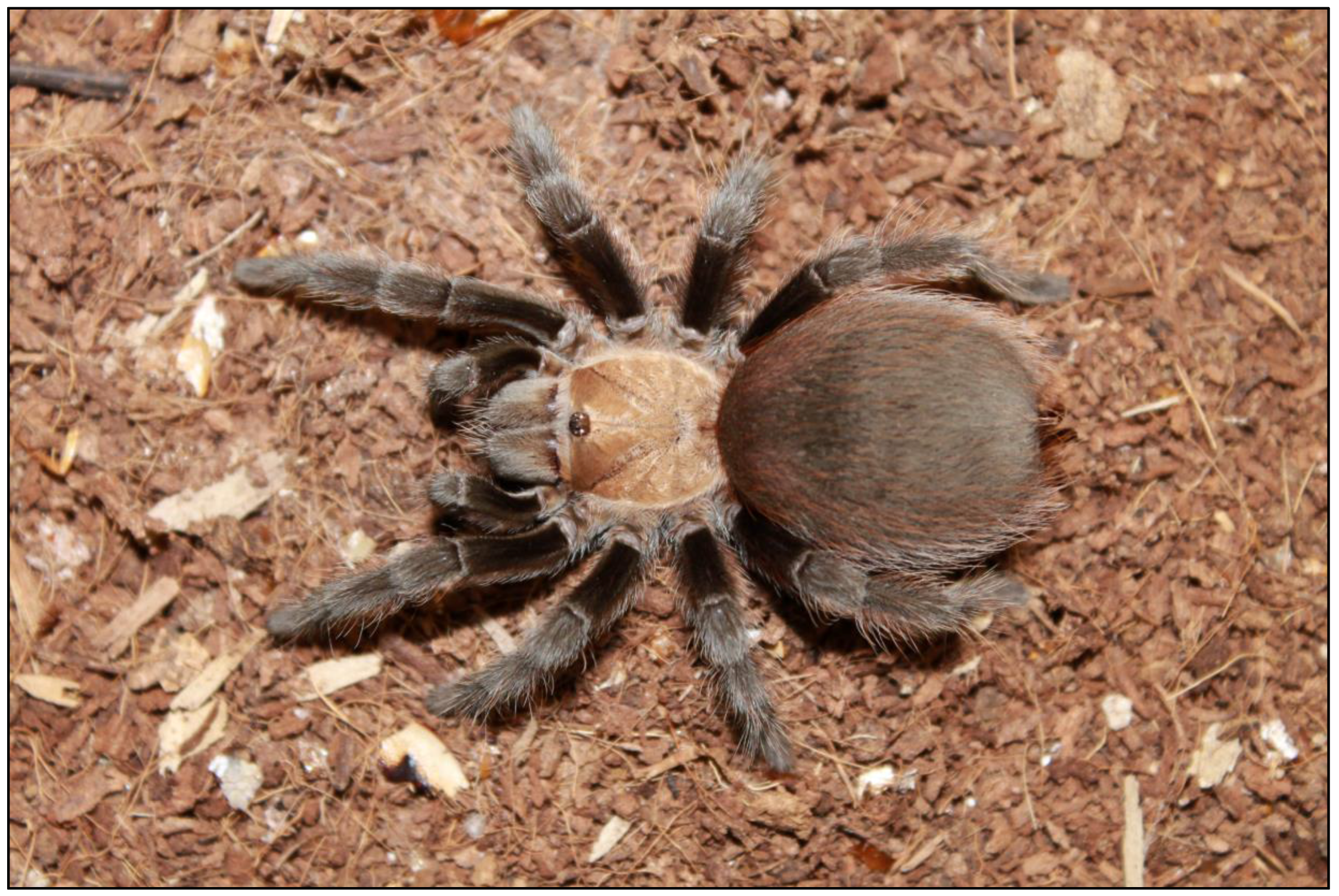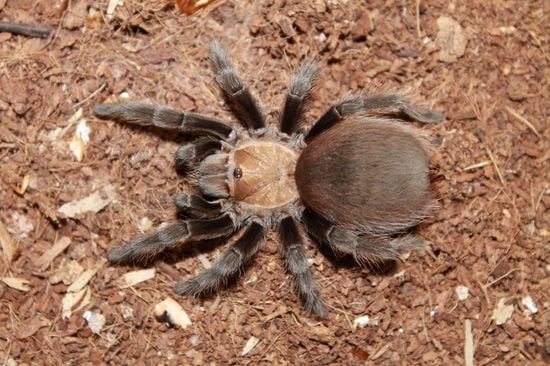Fear and Disgust of Spiders: Factors that Limit University Preservice Middle School Science Teachers
Abstract
:1. Introduction
2. Theoretical Underpinnings of the Study
2.1. Human Fear and Human Disgust
2.2. Human Belief
3. Literature Review
3.1. Spiders: A Brief Overview
3.2. Research Addressing the Use of Arthropods in Educational Settings with Preservice Teachers
4. Materials and Methods
4.1. Research Questions
- Did the spider activities change the participants’ levels of fear toward spiders?
- Did the spider activities change the participants’ levels of disgust toward spiders?
- Did the spider activities change the participants’ beliefs concerning the likelihood of incorporating information about spiders into their science classroom?
- Did the spider activities change the participants’ beliefs concerning the likelihood of incorporating information about the ecological services of spiders into their science classroom?
4.2. Study Participants
4.3. Study Procedure
4.4. Overview of the Spider Activities
4.5. Statistical Analysis
5. Results
6. Discussion
6.1. Findings
6.2. Implications of the Study
6.3. Future Research
7. Conclusions
Author Contributions
Conflicts of Interest
References
- Lewis, R.; Gaffin, D.; Hoefnagels, M.; Parker, B. Life; McGraw-Hill: New York, NY, USA, 2002. [Google Scholar]
- Wilson, E.O. The little things that run the world (the importance and conservation of invertebrates). Conserv. Biol. 1987, 1, 344–346. [Google Scholar] [CrossRef]
- Gerdes, A.B.M.; Uhl, G.; Alpers, G.W. Spiders are special: Fear and disgust evoked by pictures of arthropods. Evol. Hum. Behav. 2009, 30, 66–72. [Google Scholar] [CrossRef]
- Wagler, A.; Wagler, R. Arthropods and the current great mass extinction: Effective themes to decrease arthropod fear and disgust and increase positive environmental beliefs in children. Int. J. Environ. Sci. Educ. 2014, 9, 197–214. [Google Scholar]
- Golkar, A.; Selbing, I.; Flygare, O.; Öhman, A.; Olsson, A. Other people as means to a safe end vicarious extinction blocks the return of learned fear. Psychol. Sci. 2013, 24, 2182–2190. [Google Scholar] [CrossRef] [PubMed]
- Prokop, P.; Uşak, M.; Fančovičová, J. Risk of parasite transmission influences perceived vulnerability to disease and perceived danger of disease-relevant animals. Behav. Process. 2010, 85, 52–57. [Google Scholar] [CrossRef] [PubMed]
- Oaten, M.; Stevenson, R.J.; Case, T.I. Disgust as a disease-avoidance mechanism. Psychol. Bull. 2009, 135, 303–321. [Google Scholar] [CrossRef] [PubMed]
- Klein, A.M.; Becker, E.S.; Rinck, M. Approach and avoidance tendencies in spider fearful children: The approach-avoidance task. J. Child Fam. Stud. 2011, 20, 224–231. [Google Scholar] [CrossRef] [PubMed]
- Curtis, V.; Aunger, R.; Rabie, T. Evidence that disgust evolved to protect from risk of disease. Proc. R. Soc. B (Suppl.) 2004, 271, S131–S133. [Google Scholar] [CrossRef] [PubMed]
- Davey, G.C.L. The “disgusting” spider: The role of disease and illness in the perpetuation of fear of spiders. Soc. Anim. 1994, 2, 17–25. [Google Scholar] [CrossRef]
- Prugnolle, F.; Lefevre, T.; Renaud, F.; Moller, A.P.; Missea, D.; Thomas, F. Infection and body odours: Evolutionary and medical perspectives. Infect. Genet. Evol. 2009, 9, 1006–1009. [Google Scholar] [CrossRef] [PubMed]
- Ohman, A.; Mineka, S. Fears, phobias, and preparedness: Toward an evolved module of fear and fear learning. Psychol. Rev. 2001, 108, 483–522. [Google Scholar] [CrossRef] [PubMed]
- Barrett, H.C. Adaptations to predators and prey. In The Handbook of Evolutionary Psychology; Buss, D.M., Ed.; Wiley: New York, NY, USA, 2005; pp. 200–223. [Google Scholar]
- Thorpe, S.J.; Salkovskis, P.M. Phobic beliefs: Do cognitive factors play a role in specific phobias? Behav. Res. Ther. 1995, 33, 805–813. [Google Scholar] [CrossRef]
- Eagly, A.H.; Chaiken, S. Attitude structure and function. In Handbook of Social Psychology; Gilbert, D., Fiske, S.T., Lindsey, G., Eds.; McGraw-Hill: Boston, MA, USA, 1998; Volume 1, pp. 269–322. [Google Scholar]
- Albarracín, D.; Johnson, B.T.; Zanna, M.P. The Handbook of Attitudes; Erlbaum, L., Ed.; Mahwah: Mahwah, NJ, USA, 2005. [Google Scholar]
- Cronin-Jones, L.L. Science teacher beliefs and their influence on curriculum implementation: Two case studies. J. Res. Sci. Teach. 1991, 28, 235–250. [Google Scholar] [CrossRef]
- Johnson, G.B. The Living World; McGraw Hill: New York, NY, USA, 2003. [Google Scholar]
- Nyffeler, M.; Sunderland, K.D. Composition, abundance and pest control potential of spider communities in agroecosystems: A comparison of European and US studies. Agric. Ecosyst. Environ. 2003, 95, 579–612. [Google Scholar] [CrossRef]
- Strickman, D.; Sithiprasasna, R.; Southard, D. Bionomics of the spider, Crossopriza lyoni (Araneae, Pholcidae), a predator of dengue vectors in Thailand. J. Arachnol. 1997, 25, 194–201. [Google Scholar]
- Georgiev, A.V.; Thompson, M.E.; Lotana, A.L.; Wrangham, R.W. Seed predation by bonobos (Pan paniscus) at Kokolopori, Democratic Republic of the Congo. Primates 2011, 52, 309–314. [Google Scholar] [CrossRef] [PubMed]
- Yen, A.L.; Ro, S. The sale of tarantulas in Cambodia for food or medicine: Is it sustainable? J. Threat. Tax. 2013, 5, 3548–3551. [Google Scholar] [CrossRef]
- Wagler, R.; Wagler, A. Assessing the attitudes and beliefs of preservice middle school science teachers toward biologically diverse animals. Int. J. Environ. Sci. Educ. 2015, 10, 271–286. [Google Scholar]
- Weinburgh, M. The effect of Tenebrio obscurus on elementary preservice teachers’ content knowledge, attitudes, and self-efficacy. J. Sci. Teach. Educ. 2007, 18, 801–815. [Google Scholar] [CrossRef]
- Wagler, R. The association between preservice elementary teacher animal attitude and likelihood of animal incorporation in future science curriculum. Int. J. Environ. Sci. Educ. 2010, 5, 353–375. [Google Scholar]
- Wagler, R.; Wagler, A. Arthropods: Attitude and incorporation in preservice elementary teachers. Int. J. Environ. Sci. Educ. 2011, 6, 229–250. [Google Scholar]
- Wagler, R.; Wagler, A. External insect morphology: A negative factor in attitudes toward insects and likelihood of incorporation in future science education settings. Int. J. Environ. Sci. Educ. 2012, 7, 313–325. [Google Scholar]
- Wagler, R.; Wagler, A. Knowledge of arthropod carnivory and herbivory: Factors influencing preservice elementary teacher’s attitudes and beliefs toward arthropods. Int. J. Environ. Sci. Educ. 2013, 8, 303–318. [Google Scholar] [CrossRef]
- Wagler, A.; Wagler, R. Beliefs about future curriculum: How avoidance emotions affect curriculum choice in science. Soc. Anim. 2016, 24, 596–617. [Google Scholar]
- Wagler, R.; Wagler, A. Understanding how preservice teachers’ fear, perceived danger and disgust affects the incorporation of arachnid information into the elementary science classroom. Int. J. Environ. Sci. Educ. 2017, 12, 213–231. [Google Scholar]
- Wagler, R. Teaching with tarantulas. Sci. Scope 2015, 38, 52–59. [Google Scholar] [CrossRef]
- A Guide for Acquiring and Caring for Tarantulas Appropriate for the Middle School Science Classroom. Available online: http://www.nsta.org/middleschool/connections/201504Wagler.pdf (accessed on 6 September 2017).
- The R Project for Statistical Computing. Available online: http://www.r-project.org/ (accessed on 6 September 2017).
- Christensen, R.H.B. Ordinal: Regression models for ordinal data. R package version 2015.1-21. Available online: https://cran.r-project.org/web/packages/ordinal/index.html (accessed on 6 September 2017).
- Benjamini, Y.; Yekutieli, D. The control of the false discovery rate in multiple testing under dependency. Ann. Stat. 2001, 29, 1165–1188. [Google Scholar]
- The IUCN Red List of Threatened Species. Available online: http://www.iucnredlist.org/ (accessed on 6 September 2017).
- Wagler, R. 6th mass extinction. In Encyclopedia of the Anthropocene: Biodiversity; DellaSala, D., Goldstein, M., Eds.; Elsevier: Oxford, UK, 2018; Volume 3, pp. 9–12. [Google Scholar]
- Bursal, M.; Paznokas, L. Math anxiety and preservice elementary teachers’ confidence to teach mathematics and science. Sch. Sci. Math. 2006, 106, 173–180. [Google Scholar] [CrossRef]

| Group | Time | Fear | Disgust | LIS | LIES |
|---|---|---|---|---|---|
| Control | Test One | 3.74 (1.28) | 3.71 (1.40) | 2.11 (0.71) | 2.10 (0.80) |
| Treatment | Test One | 3.83 (1.25) | 3.84 (1.31) | 2.11 (0.70) | 2.12 (0.77) |
| Control | Test Two | 3.69 (1.29) | 3.67 (1.40) | 2.16 (0.72) | 2.13 (0.82) |
| Treatment | Test Two | 2.40 (0.93) | 2.51 (0.77) | 3.40 (0.65) | 3.40 (0.56) |
| Fear | Disgust | LIS | LIES | |
|---|---|---|---|---|
| Fear | 1 | 0.320 | −0.250 | −0.238 |
| Disgust | 3.06 × 10−9 | 1 | −0.191 | −0.269 |
| LIS | 6.64 × 10−24 | 2.64 × 10−32 | 1 | 0.379 |
| LIES | 6.87 × 10−13 | 5.03 × 10−36 | 3.35 × 10−41 | 1 |
| Fear | Fear p-Values | Disgust | Disgust p-Values | LIS | LIS p-Values | LIES | LIES p-Values | |
|---|---|---|---|---|---|---|---|---|
| Male | −0.783 | 0.238 (0.821) | −0.383 | 0.623 (0.807) | 0.527 | 0.478 (0.940) | 0.156 | 0.730 (0.768) |
| Age | −0.006 | 0.799 (0.821) | −0.003 | 0.858 (0.858) | −0.003 | 0.911 (0.987) | −0.013 | 0.432 (0.768) |
| Hispanic | −0.790 | 0.600 (0.821) | −1.867 | 0.296 (0.807) | 0.958 | 0.537 (0.940) | −0.284 | 0.768 (0.768) |
| White | −0.735 | 0.679 (0.821) | −1.053 | 0.623 (0.807) | 0.410 | 0.825 (0.987) | −0.967 | 0.406 (0.768) |
| Treatment | 0.103 | 0.821 (0.821) | 0.209 | 0.672 (0.807) | 0.008 | 0.987 (0.987) | 0.111 | 0.738 (0.768) |
| Post | −0.172 | 0.559 (0.821) | −0.123 | 0.691 (0.807) | 0.216 | 0.485 (0.940) | 0.120 | 0.663 (0.768) |
| Trt*Post | −3.534 | 0.000 (0.000) | −3.499 | 0.000 (0.000) | 6.270 | 0.000 (0.000) | 3.996 | 0.000 (0.000) |
© 2018 by the authors. Licensee MDPI, Basel, Switzerland. This article is an open access article distributed under the terms and conditions of the Creative Commons Attribution (CC BY) license (http://creativecommons.org/licenses/by/4.0/).
Share and Cite
Wagler, R.; Wagler, A. Fear and Disgust of Spiders: Factors that Limit University Preservice Middle School Science Teachers. Insects 2018, 9, 12. https://doi.org/10.3390/insects9010012
Wagler R, Wagler A. Fear and Disgust of Spiders: Factors that Limit University Preservice Middle School Science Teachers. Insects. 2018; 9(1):12. https://doi.org/10.3390/insects9010012
Chicago/Turabian StyleWagler, Ron, and Amy Wagler. 2018. "Fear and Disgust of Spiders: Factors that Limit University Preservice Middle School Science Teachers" Insects 9, no. 1: 12. https://doi.org/10.3390/insects9010012





